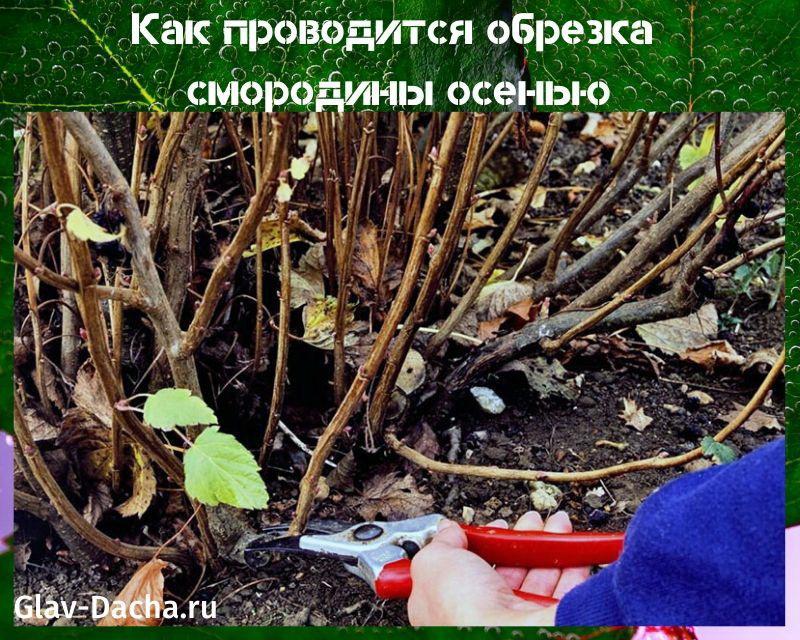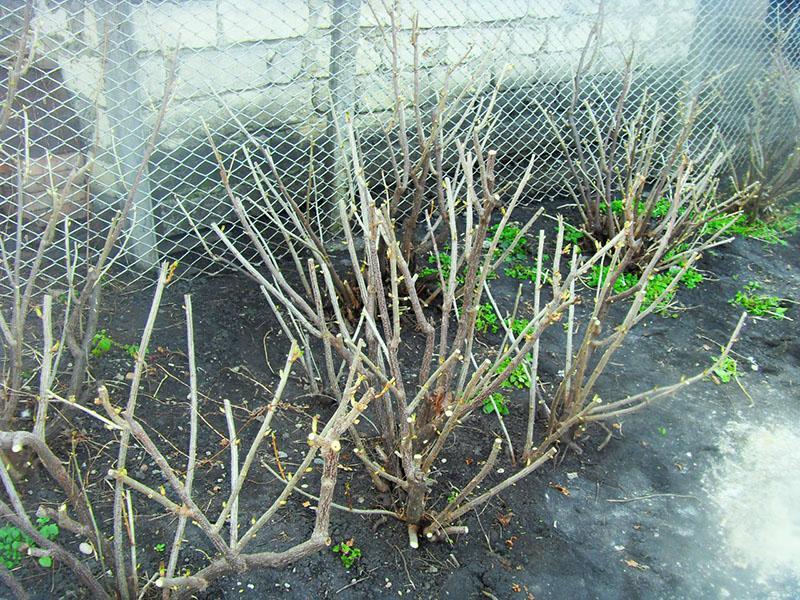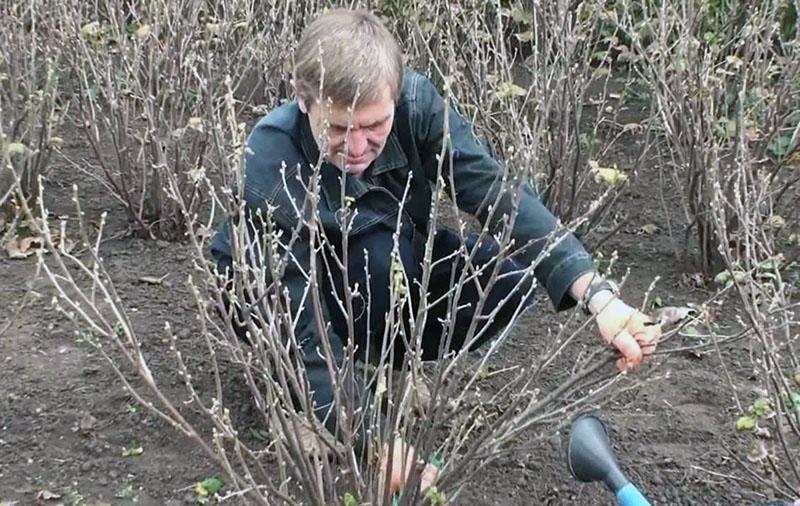How is currant pruning carried out in the fall
 Pruning currants in the fall is one of the mandatory procedures that every gardener must perform before frost. A well-chosen period for this procedure and certain rules allow you to increase fruiting in the next season, and rejuvenate the shrub.
Pruning currants in the fall is one of the mandatory procedures that every gardener must perform before frost. A well-chosen period for this procedure and certain rules allow you to increase fruiting in the next season, and rejuvenate the shrub.
Why currant pruning is required in the fall

Knowing the structure of the currant bush and the pruning scheme, even a novice gardener can cope with the procedure. Pruning is necessary not only to add decorative effect, but also to increase yields. As long as the currant is a young crop, it gives a good harvest. But after 3-4 years without proper care, the yield drops, since the old branches of the plant only absorb nutrients, without forming fruit buds. Accordingly, you need to get rid of them.
In addition to increasing yields, currant pruning is necessary:
- for better growth and development of the shrub;
- increasing the size of berries;
- improving taste;
- stimulating the growth of young shoots;
- an increase in the term of fruiting.
Therefore, the question of whether it is necessary to cut the currants is not for experienced gardeners. They know well that after the procedure, nutrients are supplied to each branch, the bush is better illuminated by the sun's rays.
Pruning currants in the fall: the benefits of the procedure
Autumn pruning of currants has several advantages:
- the formation of the bush is much more efficient, since by this time the sap flow has been completed;
- fungal diseases affecting old branches do not spread to new shoots;
- insect pests cannot hide for the winter in old shoots.
Pruning currants in the fall will minimize damage during the growing season. The procedure should not be performed annually. After high-quality pruning, the currants can be left for 2-3 years without forming a bush.
Plant a currant bush in open ground it is necessary 2-3 weeks before the expected frost. From the moment of planting, care can begin, which will have a beneficial effect on the subsequent fruiting and yield of the crop.
Pruning in the spring is undesirable, although many gardeners use this method. In the spring, it is dangerous to prune, since the plant may already have sap flow by this time, buds appear early. In addition, in early spring, there is a high probability of night frosts.
In terms of timing, pruning of currants should be scheduled for late October - early November. At this time, the vegetative processes in the plant are over, and the currants will not receive stress.
It is important to wait for the bush to shed its leaves - this will make it easier to assess the condition of the branches. For the same reason, it is advisable to choose a sunny day for the procedure.
Pruning equipment

Pruning black currants in the fall will require the preparation of special equipment, which will be needed during the procedure. All instruments should be sharpened and disinfected in advance. This will help you cut neatly and keep the infection from spreading.
From the inventory you will need:
- garden knife - it is used only on thin branches;
- hacksaw - you need it to remove thick branches;
- the brush cutter can handle any branches and help to arrange the bush;
- secateurs - it is used for thin and medium branches;
- lopper - it is convenient for them to remove branches in hard-to-reach places, since they have long handles.
Keep the tool at right angles while trimming. Slices are made 0.5 cm above the kidney. If the shoot needs to be cut at the root, then hemp should not be allowed, it should be cut near the ground.
Pruning procedure
 Pruning red and black currants should be done following some basic rules used by experienced gardeners. They prefer to proceed in stages. First you need to do sanitary pruning.
Pruning red and black currants should be done following some basic rules used by experienced gardeners. They prefer to proceed in stages. First you need to do sanitary pruning.
It includes the following steps:
- liberation of shrubs from sick, rotten, dried up and broken branches;
- cut off shoots that are not ripe in summer;
- remove branches lying on the ground and intertwined in the middle of the bush.
Then you can start the next stage - anti-aging. To do this, you need to get rid of those branches that are more than 5-7 years old. Shoots that have appeared in the current year should be shortened by a third.
Then it is necessary to carry out maintenance pruning. It should be carried out at a time when the bush looks unkempt. You need to cut off the branches from the middle so that the sun's rays penetrate into the bush. But one should not be overly involved in this process, otherwise the culture will experience severe stress.
 Many gardeners use radical blackcurrant pruning methods. This procedure is performed if the yield drops sharply. It can be performed both in spring and autumn. It consists in the complete pruning of currants at a height of 3 cm from the ground. It is important to feed the soil. This method will allow new, viable shoots to grow in the spring.
Many gardeners use radical blackcurrant pruning methods. This procedure is performed if the yield drops sharply. It can be performed both in spring and autumn. It consists in the complete pruning of currants at a height of 3 cm from the ground. It is important to feed the soil. This method will allow new, viable shoots to grow in the spring.
A good way to prune currants in the fall is recommended for beginner gardeners who do not yet have experience and certain skills. At the same time, beginners do not need to understand the age of the shoots. All branches that have grown by less than 15 cm during the summer should be cut.
Many gardeners recommend sticking to the timing of pruning the lunar calendar. However, in any case, you will need to wait until the end of fruiting.
Bush formation methods
For beginners in gardening, standard currant pruning is more suitable for the type of regular shrub. Recently, however, many have been using more decorative methods.
Stam

To form a small tree, you need to do the following:
- the first year, pruning should be normal;
- after 6 months, it is recommended to remove zero and young shoots;
- a year later, on the main branches, it is necessary to cut off the entire growth, and shorten the remaining ones to 5 cm;
- next spring it is necessary to cut the lateral shoots up to 3 cm and thick branches succeeded.
On the trellis
 You can trim the currants under the trellis as follows: the lateral shoots are cut to 5 cm and all branches that are on the soil surface are trimmed. The main barrel does not need to be touched. Then, as the plant develops, the root and shoots located close to the ground are removed. A similar method of forming a bush increases the flavor characteristics of the berries.
You can trim the currants under the trellis as follows: the lateral shoots are cut to 5 cm and all branches that are on the soil surface are trimmed. The main barrel does not need to be touched. Then, as the plant develops, the root and shoots located close to the ground are removed. A similar method of forming a bush increases the flavor characteristics of the berries.
Pruning currants in the fall according to Michurin technology
 The trimming scheme is very simple. The shrub is not touched until 5 years of age. Only sanitary pruning can be done. After a year, all branches are cut, leaving only 15-20 strong and young shoots. For the next season, you should leave about 10 branches, cut off those that are more than 5 years old.
The trimming scheme is very simple. The shrub is not touched until 5 years of age. Only sanitary pruning can be done. After a year, all branches are cut, leaving only 15-20 strong and young shoots. For the next season, you should leave about 10 branches, cut off those that are more than 5 years old.
Care after pruning
 After pruning the currant bush in the fall, you need to have time to complete a certain list of care measures. This is very important as it will help the culture survive the winter.
After pruning the currant bush in the fall, you need to have time to complete a certain list of care measures. This is very important as it will help the culture survive the winter.
These activities include:
- introduction into the soil of mineral and organic fertilizers;
- loosening the soil;
- preventive measures for processing plants from insect pests and diseases;
- mulching the soil around the shrub.
It is also important to treat all slices on currants with a special antiseptic. In the northern regions of our country, it will be necessary to cover the root system and the plant itself. To do this, it is enough to bend the branches closer to the ground, put some kind of oppression on top. Any suitable fabric can be used as a covering material.
The cuts are processed with a garden pitch. For cooking, you need 6 parts of rosin, 2 parts of propolis, part of turpentine and 3 parts of wax. Everything needs to be melted in a water bath, at the end add rosin. After boiling, cool, mix with turpentine. The mass is carefully applied to the sections.
The nuances of pruning red and white currants
 Red and white currant varieties require a different approach to shrub formation. Many varieties prefer spring pruning, but, in any case, a number of work must be done in the fall.
Red and white currant varieties require a different approach to shrub formation. Many varieties prefer spring pruning, but, in any case, a number of work must be done in the fall.
The main features of pruning red and white currant varieties:
- Since the fruiting period lasts 6-8 years, then rejuvenation of the bush is required by removing old branches.
- The first few years the bush grows in height. 2 and 3-year-old branches bear fruit, therefore the frame of the bush is formed from the strongest branches and some lateral ones. Branches that do not bear fruit are subject to pruning.
- The optimal number of branches on one shrub for a good harvest in the next season is no more than 15, while they should be of different ages.
- In most varieties of red and white currants, it is impossible to pinch in the summer and trim the tops of young branches after the end of fruiting.
- Many varieties of red currant form basal shoots as they grow and develop. During anti-aging pruning, it is important to leave 3-4 strong shoots, and remove the rest.
The growth and development of red and white currants will require careful monitoring, especially in relation to fruiting branches. In the fall, those segments that have not yielded are cut off.
If autumn pruning of currants is planned, then the procedure can be started after the leaves have flown. Since currants lose their green mass rather early, around September, then if you wish, you can do pruning. If autumn is expected to be warm, it is better to wait until October-November.
Common mistakes gardeners make
 It is clear that pruning is necessary for the growth and full development of garden culture. The most correct, according to experienced gardeners, is the autumn pruning procedure. But it happens that beginners make some mistakes, which then affect fruiting. One of the most common mistakes is insufficient deletion of branches. They are pitied and not disposed of, and as a result, the plant spends energy on feeding old, unnecessary segments. Another common mistake is the wrong pruning date. Currants are subjected to the procedure only after the cessation of sap flow and before frost.
It is clear that pruning is necessary for the growth and full development of garden culture. The most correct, according to experienced gardeners, is the autumn pruning procedure. But it happens that beginners make some mistakes, which then affect fruiting. One of the most common mistakes is insufficient deletion of branches. They are pitied and not disposed of, and as a result, the plant spends energy on feeding old, unnecessary segments. Another common mistake is the wrong pruning date. Currants are subjected to the procedure only after the cessation of sap flow and before frost.
Given the basic rules and order of pruning, you can maintain good yields for a long time at the highest level.
